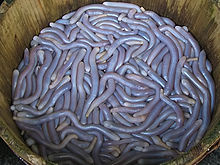Common splashworm
| Common splashworm | ||||||||||||
|---|---|---|---|---|---|---|---|---|---|---|---|---|

Sipunculus nudus |
||||||||||||
| Systematics | ||||||||||||
|
||||||||||||
| Scientific name | ||||||||||||
| Sipunculus nudus | ||||||||||||
| Linnaeus , 1766 |
The common injection worm or naked injection worm ( Sipunculus nudus ) is a large species of injection worms (Sipuncula) from the family of Sipunculidae that lives in the sand in warmer temperate and tropical seas around the world.
features
The cylindrical, slightly distended, flesh-colored trunk of Sipunculus nudus has a latticed pattern and is up to 35 cm long.
The introvert, the retractable trunk-like front section of the worm, has no hooks but is covered with large, flattened, triangular papillae that point backwards. The mouth disc at the tip of the introvert has a large, strongly folded tentacle flap, the edge of which does not, however, form pronounced tentacles. The lattice-like surface structure of the torso is formed by grooves that run between the circular and longitudinal muscles of the skin muscle tube that are located under the skin . In small animals that do not yet reach 3.5 cm, this structure is not yet visible from the outside.
The exits of the nephridia are on the abdomen on the side in front of the anus, which is located on the front part of the trunk. The external circular muscles and the diagonal and longitudinal muscles connected inwards are combined in bundles and contain longitudinal canals that are connected to the coelom at intervals . There are 28 to 34 longitudinal muscle bundles in the front of the trunk, but fewer in the rear.
There are four retraction muscles on the inside, which start at the front of the trunk approximately at the level of the anus and extend at their base over 4 to 8 muscle bundles. The intestine, which is slightly wound into a double spiral, is held in place by numerous muscles and supported by a spindle muscle next to the anus, but not at the rear end of the trunk. There is a characteristic, smaller bowel loop between the esophagus and the main spiral of the bowel. The appendix in the anus area can vary in size and is usually small. Two contractile blood vessels run along the back and abdomen along the esophagus. The two nephridia are attached to a quarter of their length. Each side of the rectum has a branched gland.
Distribution and occurrence
The common splashworm is found as a cosmopolitan in warmer temperate and tropical waters of all major oceans worldwide. In addition to the Caribbean , frequent sites are also the west coast of Ireland , the southwestern North Sea and the eastern Mediterranean . It lives in the sand from the deeper areas of the intertidal zone down to a depth of 700 m.
nutrition
Sipunculus nudus grazes with the tentacles of its mouth disc at the tip of the everted introvert detritus and microorganisms from the sandy substrate. The food particles are swallowed as lumps by the turned-in introvert.
Life cycle
The common injection worm is sexually separated with males and females of equal size. The gametes are released into the sea water, where fertilization takes place. Free-swimming larvae that live as zooplankton develop , which develop from a pericalymma to a pelagosphaera before they sink after a few weeks and metamorphose into crawling worms .
Importance to humans
Sipunculus nudus is used as food in many countries in Asia, such as China and Vietnam .
literature
- Johannes Fischer (1913): The Sipunculoideen of the North and Baltic Seas taking into account the shapes of the North Atlantic area. Inaugural dissertation to obtain a doctorate from the high philosophical faculty of the Royal Christian Albrechts University in Kiel.
- JD Fish, S. Fish: A Student's Guide to the Seashore. Cambridge University Press, Cambridge 2011. p. 379 (ill. P. 378).
Web links
- MJ de Kluijver et al .: Sipunculus nudus Linnaeus, 1766. Marine Species Identification Portal
- Underwater World Mediterranean: Sipunculus (Sipunculus) nudus - Common splashworm
Individual evidence
- ^ Claus Nielsen: Animal Evolution: Interrelationships of the Living Phyla. OUP Oxford, 2012. p. 137.
- ↑ Lan Guobao, Yan Bing (2002): The reproductive biology of peanut worm, Sipunculus nudus. Shuichan Xuebao 26 (6), pp. 503-509.
